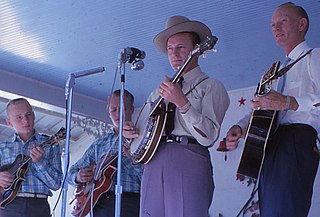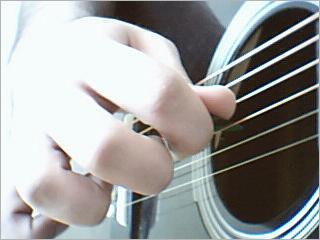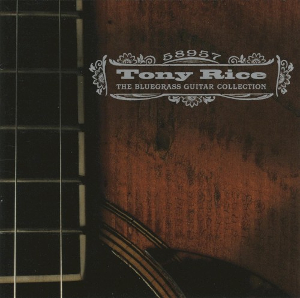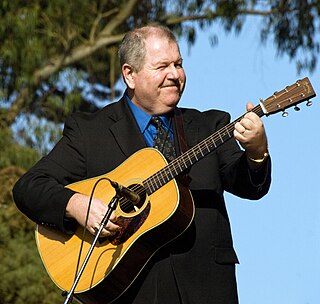The banjo is a stringed instrument with a thin membrane stretched over a frame or cavity to form a resonator. The membrane is typically circular, in modern forms usually made of plastic, originally of animal skin. Early forms of the instrument were fashioned by African Americans and had African antecedents. In the 19th century, interest in the instrument was spread across the United States and United Kingdom by traveling shows of the 19th century minstrel show fad, followed by mass-production and mail-order sales, including instruction method books. The inexpensive or home-made banjo remained part of rural folk culture, but 5-string and 4-string banjos also became popular for home parlor music entertainment, college music clubs, and early 20th century jazz bands. By the early 21st century, the banjo was most frequently associated with folk, bluegrass and country music, but was also used in some rock, pop and even hip-hop music. Among rock bands, the Eagles, Led Zeppelin, and the Grateful Dead have used the five-string banjo in some of their songs. Some famous pickers of the banjo are Ralph Stanley and Earl Scruggs.

A plectrum is a small flat tool used for plucking or strumming of a stringed instrument. For hand-held instruments such as guitars and mandolins, the plectrum is often called a pick and is held as a separate tool in the player's hand. In harpsichords, the plectra are attached to the jack mechanism.

Scruggs style is the most common style of playing the banjo in bluegrass music. It is a fingerpicking method, also known as three-finger style. It is named after Earl Scruggs, whose innovative approach and technical mastery of the instrument have influenced generations of bluegrass banjoists ever since he was first recorded in 1946. It contrasts with earlier styles such as minstrel, classic, or parlor style, clawhammer/frailing/two-finger style, jazz styles played with a plectrum, and more modern styles such as Keith/melodic/chromatic/arpa style and single-string/Reno style. The influence of Scruggs is so pervasive that even bluegrass players such as Bill Keith and Don Reno, who are credited with developing these latter styles, typically work out of the Scruggs style much of the time.

Clawhammer, sometimes called down-picking, overhand, or frailing, is a distinctive banjo playing style and a common component of American old-time music.

Fingerstyle guitar is the technique of playing the guitar or bass guitar by plucking the strings directly with the fingertips, fingernails, or picks attached to fingers, as opposed to flatpicking. The term "fingerstyle" is something of a misnomer, since it is present in several different genres and styles of music—but mostly, because it involves a completely different technique, not just a "style" of playing, especially for the guitarist's picking/plucking hand. The term is often used synonymously with fingerpicking except in classical guitar circles, although fingerpicking can also refer to a specific tradition of folk, blues and country guitar playing in the US. The terms "fingerstyle" and "fingerpicking" are also applied to similar string instruments such as the banjo.

Guitar tunings are the assignment of pitches to the open strings of guitars, including classical guitars, acoustic guitars, and electric guitars. Tunings are described by the particular pitches that are made by notes in Western music. By convention, the notes are ordered and arranged from the lowest-pitched string to the highest-pitched string, or the thickest string to thinnest, or the lowest frequency to the highest. This sometimes confuses beginner guitarists, since the highest-pitched string is referred to as the 1st string, and the lowest-pitched is the 6th string.

Guitar Craft (GC) was a series of guitar and personal-development classes, founded and often presented by Robert Fripp, who is best known for his work with the rock band King Crimson. Guitar Craft courses introduced students to new standard tuning and ergonomic playing with the plectrum (pick), often using steel-stringed, acoustic, shallow-body guitars from the Ovation Guitar Company.

Donald Wesley Reno was an American bluegrass and country musician, best known as a pioneering banjo and guitar player who partnered with Red Smiley, and later with guitarist Bill Harrell.

Flatpicking is the technique of striking the strings of a guitar with a pick held between the thumb and one or two fingers. It can be contrasted to fingerstyle guitar, which is playing with individual fingers, with or without wearing fingerpicks. While the use of a plectrum is common in many musical traditions, the exact term "flatpicking" is most commonly associated with Appalachian music of the American southeastern highlands, especially bluegrass music, where string bands often feature musicians playing a variety of styles, both fingerpicking and flatpicking. Musicians who use a flat pick in other genres such as rock and jazz are not commonly described as flatpickers or even plectrum guitarists. As the use of a pick in those traditions is commonplace, generally only guitarists who play without a pick are noted by the term "fingerpicking" or "fingerstyle".

Jim & Jesse were an American bluegrass music duo of brothers, Jim McReynolds and Jesse McReynolds. They were born and raised in Carfax, a community near Coeburn, Virginia, United States.

David Grier is an American acoustic guitarist. A three-time IBMA guitarist of the year, Grier has been lauded as highly influential and a master flatpicker by both music publications and his colleagues.
Allen Shelton was an American five-string banjo player mostly known for being a member of the bluegrass band Jim & Jesse and the Virginia Boys since the 1960s. Shelton was born in Rockingham County, North Carolina, on July 2, 1936. Shelton started playing the banjo when he was fourteen. His father Troy Shelton was a guitar player mainly, but also played mandolin and banjo. A local musician named Junior Biggs showed him some three-finger style rolls.

Carter Family picking, also known as the thumb brush, the Carter lick, the church lick, or the Carter scratch, is a style of fingerstyle guitar named after Maybelle Carter of the Carter Family. It is a distinctive style of rhythm guitar in which the melody is played on the bass strings, usually low E, A, and D while rhythm strumming continues above, on the treble strings, G, B, and high E. This often occurs during the break. The style bears similarity to the frailing style of banjo playing and is the rhythm Bill Monroe adapted for bluegrass music two decades later.

Guitar picking is a group of hand and finger techniques a guitarist uses to set guitar strings in motion to produce audible notes. These techniques involve plucking, strumming, brushing, etc. Picking can be done with:
George Shuffler was an American bluegrass guitar player and an early practitioner of the crosspicking style. During his career Shuffler played with The Bailey Brothers, The Stanley Brothers and Ralph Stanley's Clinch Mountain Boys. He was a 2007 recipient of the North Carolina Heritage Award and in 2011 was elected to the International Bluegrass Music Hall of Fame.

58957: The Bluegrass Guitar Collection is a compilation album by American guitarist Tony Rice, released in 2003. The title is derived from the serial number of a 1935 Martin D-28 guitar previously owned by the seminal bluegrass guitarist Clarence White and now owned by Rice.

In bluegrass music, a banjo roll or roll is a pattern played by the banjo that uses a repeating eighth-note arpeggio – a broken chord – that by subdividing the beat 'keeps time'. "Each ["standard"] roll pattern is a right hand fingering pattern, consisting of eight (eighth) notes, which can be played while holding any chord position with the left hand."

James Alan Shelton was an American bluegrass guitarist. Shelton was a solo musician, released 10 albums, and performed with the Clinch Mountain Boys.

Bluegrass mandolin is a style of mandolin playing most commonly heard in bluegrass bands.
In music, a chop chord is a "clipped backbeat". In 4
4: 1 2 3 4. It is a muted chord that marks the off-beats or upbeats. As a rhythm guitar and mandolin technique, it is accomplished through chucking, in which the chord is muted by lifting the fretting fingers immediately after strumming, producing a percussive effect.
The chop is analogous to a snare drum beat and keeps the rhythm together and moving. It's one of the innovations bluegrass inventor Bill Monroe pioneered, and it gave the music a harder groove and separated it from old-time and mountain music.

















